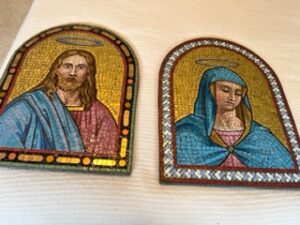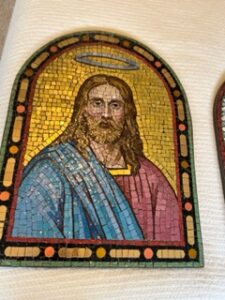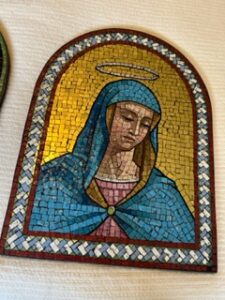 CR owns a pair of religious mosaics, one a Christ figure and one of Mary. These exceptional mosaics measure fifteen by twenty inches, weighing eighteen pounds, set in lead. He believes his parents acquired them in the 1930s.
CR owns a pair of religious mosaics, one a Christ figure and one of Mary. These exceptional mosaics measure fifteen by twenty inches, weighing eighteen pounds, set in lead. He believes his parents acquired them in the 1930s.
First, I will talk about their ‘heritage’ or style, and second, give a replacement valuation. I didn’t find comparable sales of such pieces in the market today, from the 1930s or older.
Christ Pantocrator
The image of Christ we call “Christ Pantocrator,” a specific depiction of Christ, meaning “all powerful,” or omnipotent, derived from the Greek. We see the half body image as a quite common depiction in Orthodox Christianity. Unlike CR’s Christ Pantocrator, He typically holds a book in one hand. The other hand’s fingers form the shape of one of His names, the Greek letters IC or XC or both. He wears a halo. In Medieval Eastern Roman Church art the image is inset in the architecture of the Church’s central dome, or in the apse, or in the nave vault.
CR’s mosaics appear made of “Smalti,” Venetian glass for mosaic, and Venetian Mosaic gold, real gold leaf under glass. This ancient medium of gold mosaics allowed reflected and bounced light to shine throughout the architecture in the daylight, and glow under the light of candle-powered chandeliers and torches at night. This must have been a sight to see.
Note the stiffness of the poses we see in CR’s images, the style we associated with Byzantium.
Religious Mosaics Restoration
 CR notes that this pair, Christ and Mother, were acquired in the 1930s, and I find that extremely significant. The great Byzantine Church, the Hagia Sophia, with the traces of its Christ Pantocrator mosaic mural, underwent restoration at that time. An eager public viewed images of what restorers found. Also, the Metropolitan Museum of Art in NYC held a public viewing in 1944 of a mosaic panel gifted to the Museum at thirteen by twenty feet, a Byzantine wonder.
CR notes that this pair, Christ and Mother, were acquired in the 1930s, and I find that extremely significant. The great Byzantine Church, the Hagia Sophia, with the traces of its Christ Pantocrator mosaic mural, underwent restoration at that time. An eager public viewed images of what restorers found. Also, the Metropolitan Museum of Art in NYC held a public viewing in 1944 of a mosaic panel gifted to the Museum at thirteen by twenty feet, a Byzantine wonder.
Perhaps in a homage to the level of public interest, and respect for this ancient art form, CR’s parents acquired these pieces in the 1930s? Some excellent work similar to this style was created in Sicily at this time.
We consider Hagia Sophia possibly the most famous of all sanctuaries for this style of mosaic art. It stood as a Christian church for eleven hundred years before Mehmed II (Ottoman Sultan) sacked Constantinople in 1204. Marauders defaced many of the murals. In 1710 Sultan Ahmet III allowed a Swedish Engineer in the “Aya Sophia” to create detailed drawings of the mosaic murals, then covered in the 18th century. In 1840 the Fossati Brothers attempted a restoration. They discovered many plastered over and painted with oil based house paint. A promising idea at the time, but the paint sealed the coverings, and condensation formed underneath.
During restoration in 1936
Restorers deemed many mosaic murals lost forever. Today the Church is the Hagia Sophia Grand Mosque, formerly the Church of Holy Wisdom. Built in 537 as a patriarchal Cathedral of the Imperial Capital of Constantinople, the largest Christian Church of the eastern Roman Empire. After the fall of Constantinople to the Ottoman Empire in 1435, they consecrated as a mosque.
Thus, I assume the art-lovers of the world in the 1930s were thrilled to purchase similar style works.
Note on valuation:
 Appraisers use three types of replacement value:
Appraisers use three types of replacement value:
- A value as concluded by comparable sales in the market,
- value concluded for a reproduction of a piece using ancient materials in the ancient style by an artist schooled in this tradition
- the value I use for CR’s pieces, which is replacement cost NEW.
I researched a few living mosaic artists who work in Smalti and gold mosaics creating Byzantine style religious images. I found that if CR wanted to insure these two pieces against a total loss, he’d receive a reimbursement of $4,000-6,000 per image.